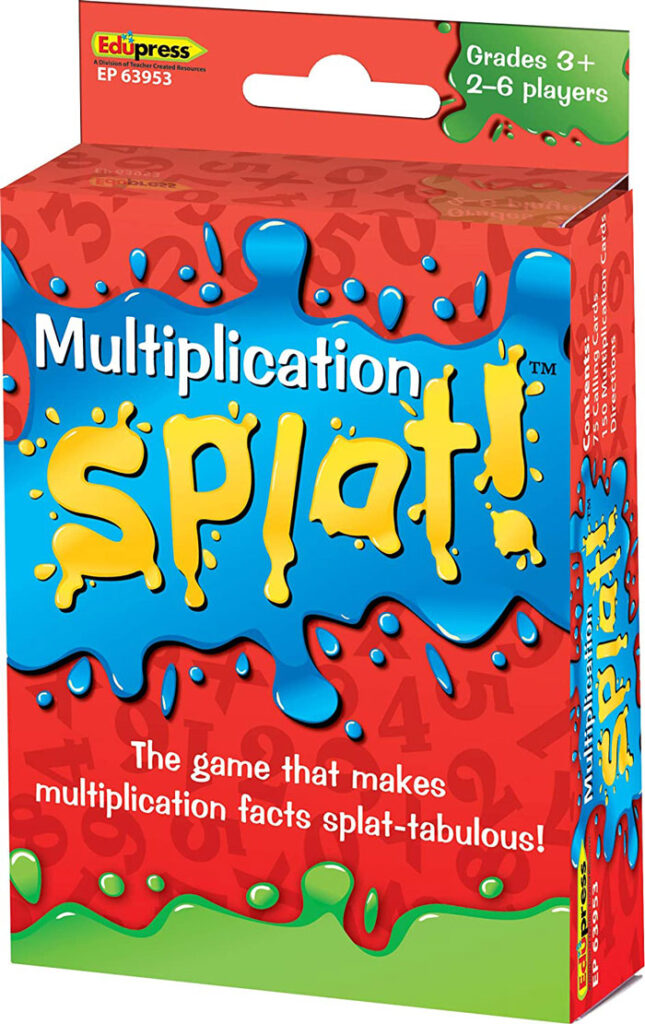“Can we play again? I like this game.” – Words from the mouth of my 10 year old. This is my new favorite way for helping my 8 and 10 year olds memorize their multiplication facts. I’ve never really been much of a flashcard person when it comes to math. My 10 year old can solve basically any multiplication problem, but he does not have many of them memorized. We played three rounds of this game today and my kids were loving it so much, THEY were the ones asking to continue.

Multiplication Splat! Details
Product: Multiplication Splat!
Company: Edupress
Recommended Age Range: 8 and up
Price Range: ~$12
Amazon Product Page (Affiliate Link)
Review
Recently I’ve been reading the book Unschooled by Kerry McDonald and it’s been making me want to approach math in an untraditional way. My kids already don’t do many math worksheets compared to their public school counterparts. (See my free printable Minimalist Math curriculum if you’re interested.) However, reading this book has made me realize that there are a lot of ways I can incorporate math in a fun way into our homeschool.
If I take the time to explore more games, projects, picture books, and intentional activities that incorporate math, I can have my kids actually CHOOSING to do math. And after all, a child motivated to do math is a child much more likely to retain what they learn. While we already have a number of games that incorporate math, this is the first game that I have purchased and been intentional about playing with my kids since reading this book.
The experience reminded me how valuable gameschooling can actually be. Initially I was planning to only play with my 10 year old, since he is the one that is behind on learning his multiplication facts. (To be fair, he does nearly all his multiplication correctly, he is just not fast.) However, my 8 year old daughter was eager to play too. Even though she is in third grade, she really doesn’t know any of her multiplication facts besides 0’s, 1’s, and 2’s.
This game was absolutely perfect. We started with an easy deck, which included at least half “easy problems” that even my 8 year old could do without too much trouble. This gave my kids confidence. However, the deck also included several that were a bit of a stretch, like 6×7, 9×9 and 11×8. Each player is dealt a hand of 6 multiplication problems. This felt very manageable. Even my 8 year old could keep track of 6 problems.
Even though I was also playing a hand, I acted as the teacher and flipped out the “call deck” of answers. In bingo-like fashion, players would see if any of their problems had the answer that was called. If so, the player says, “Splat!” and also says the entire problem then flips over that card. I felt saying the problem was really helpful, especially for my child that does not know any of the upper multiplication tables. For her, if she did not see that she had a card that matched, I would let her know and she would figure out which one.
Another aspect that I think is nice about this game is that there is a huge element of luck. It does not require kids to be fast. The way the call deck is shuffled basically determines the winner. Technically, if a child does not see that they had a multiplication problem that matched a called answer, they could lose that way, but I made sure my kids knew when they had a match if they didn’t see it on their own. Because luck is so important, the older players do not win every time. I think this makes it more fun for everyone. I actually ended up coming in last all three times which my kids loved.
We will definitely be regularly rotating Multiplication Splat! into our gaming rotation. Personally, I do not know of a more simple, effective, and fun way to practice multiplication facts.
Click here for more Board Games Reviews for kids of all ages.
Related Links:
Best Gifts for Kids
Independent Games for Kids
Best Books for Late Elementary



Leave a Reply